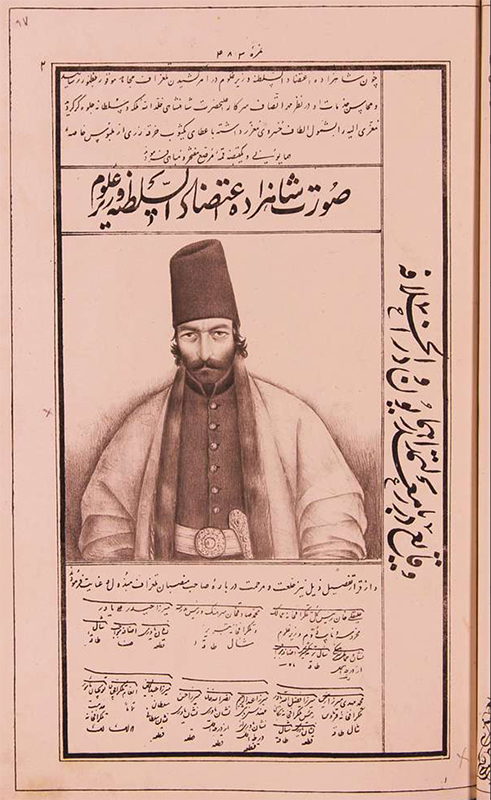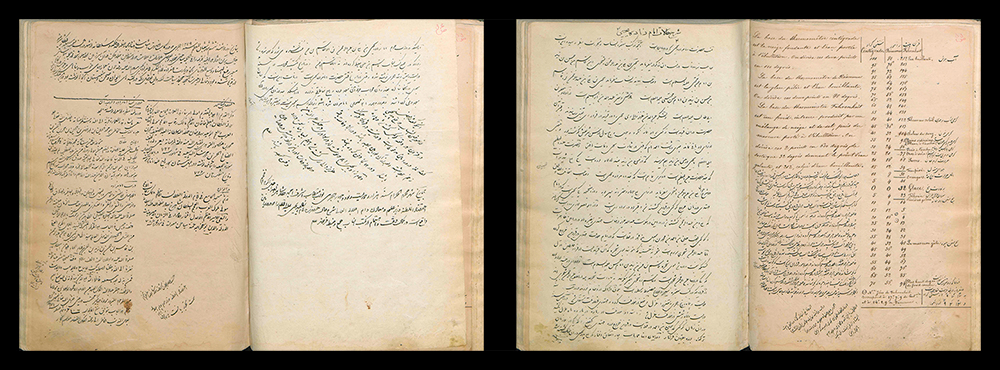The Emamzadeh Yahya Through the Eyes of ʿAliqoli Mirza Eʿtezad al-Saltaneh: Notes from a Qajar Court Visit to Varamin in 1279/1863 and a Biography of Emamzadeh Yahya dated 1294/1877
Hossein Nakhaei and Keelan Overton
In 1863, Qajar prince and minister of science ʿAliqoli Mirza Eʿtezad al-Saltaneh (d. 1880) accompanied Naser al-Din Shah (r. 1848–96) and his royal court on a visit to Varamin (figs. 1–2). During their pious visit (ziyarat) to the Emamzadeh Yahya, Eʿtezad al-Saltaneh ordered the recording of some of the tomb’s inscriptions, including its Ilkhanid-period luster mihrab and stucco inscription and Safavid-period wooden door. The latter included the lineage of Yahya b. ʿAli (d. 869–70) and traced his decent to Emam Hasan (d. 670), the second Shiʿi Emam.


Fourteen years later, following the publication of fellow courtier Mohammad Hasan Khan Eʿtemad al-Saltaneh’s (d. 1896) account of the Emamzadeh Yahya and assertion that Yahya b. ʿAli was a descendant of Emam Musa (d. 799), the seventh Shiʿi Emam, Eʿtezad al-Saltaneh completed a biography of the saint using genealogical sources, including two from the tenth century. He ultimately inserted this text and the 1863 field notes into his jong, a composite codex preserving a variety of materials (fig. 3).

In this interactive Storiiies feature, we provide a detailed tour of these two texts across three folios, illuminating how the saint and his tomb were understood, studied, and valued in some Qajar court circles.
Explore the Folios
To enter this feature directly and experience it on a wider screen, please visit Storiiies.
Source:
- «شرح حالات امامزاده یحیی». مورخ محرم ۱۲۹۴ق. گردآوری [وتحقیق؟] توسط علیقلی میرزا اعتضادالسلطنه. در: جُنگ نظم و نثر، نسخهی دستنویس در کتابخانهی مجلس شورای اسلامی در تهران، شمارهی ۱۴۵۳سس.، ۵۶ الف – ۵۶ ب.
- نامعلوم. [گزارش سفر ورامین به همراه کاروان ناصرالدینشاه قاجار]. مورخ شعبان ۱۲۷۹ق. نوشتهشده به دستور علیقلی میرزا اعتضادالسلطنه. در: جنگ نظم و نثر، نسخهی دستنویس در کتابخانهی مجلس شورای اسلامی در تهران، شمارهی ۱۴۵۳سس.، ۵۷ الف.
- The two texts above are combined as:
“Sharh-e halat-e Emamzadeh Yahya” (Biography of Emamzadeh Yahya), dated Moharram 1294/ January 1877 (56a–56b), and Varamin field notes from the royal visit in Shaʿban 1279 AH/ January 1863 (57a), preserved in the jong of ʿAliqoli Mirza Eʿtezad al-Saltaneh. The Library, Museum and Document Center of the Islamic Parliament of Iran (Ketabkhaneh, Muzeh va Markaz-e Asnad-e Majles-e Shora-ye Eslami), Tehran, 1453/س.س. ۱۴۵۳ , fols. 56a–57a.
Practical resources:
- Library, Museum and Document Center of the Islamic Parliament of Iran (or Majles Library): map, website
- The text (biography and field notes) on Lib.ir
- For more on Eʿtezad al-Saltaneh and his role in state-sponsored education, communication, publishing, and cultural initiatives generally, see this entry in Encyclopaedia Iranica
- For the copy of Eʿtezad al-Saltaneh’s jong ordered by his successor in the 1890s, see the Malek National Library and Museum Institution in Tehran, 1393.04.6151/059. Sections of the text are accessioned individually and available online. For the Varamin section, see p. 129–32.
Related pages:
- Ahmad Khamehyar’s essay on Emamzadehs and their tombs (in Persian and English translation)
- Our essay on the historical evolution of the Emamzadeh Yahya complex
- Our essay on the stucco inscription inside the tomb
- Catalog entry on the tomb’s Safavid door, no. 15
Acknowledgements: We are grateful to Hamidreza Ghelichkhani for sharing his opinion and insight on some codicological details. We also thank Jake Benson for providing feedback on a draft.
Citation: Hossein Nakhaei and Keelan Overton, “The Emamzadeh Yahya Through the Eyes of ʿAliqoli Mirza Eʿtezad al-Saltaneh: Notes from a Qajar Court Visit to Varamin in 1279/1863 and a Biography of Emamzadeh Yahya dated 1294/1877.” Interactive feature in The Emamzadeh Yahya at Varamin: An Online Exhibition of an Iranian Shrine, directed and edited by Keelan Overton. 33 Arches Productions, January 15, 2025. Host: Khamseen: Islamic Art History Online.
